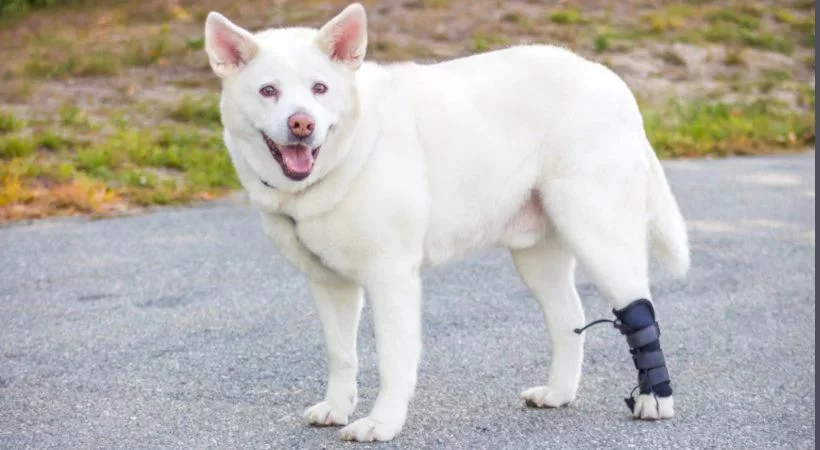Why Is My Dog Dragging Its Back Legs?
As a dog owner, watching your beloved pet struggle with mobility issues can be heartbreaking. Recently, I noticed my dog dragging its back legs, which made me deeply concerned. After consulting with a veterinarian and doing some research, I learned a lot about the potential causes behind this condition. If you're dealing with the same issue, this article will guide you through the possible reasons and solutions to help your furry friend regain their mobility.
What Causes a Dog to Drag Its Back Legs?
There are several reasons why a dog might start dragging its back legs. Some of the most common causes include:
- Intervertebral Disc Disease (IVDD): This is one of the most frequent causes of back leg paralysis in dogs. It occurs when the discs in the spine deteriorate or herniate, leading to pressure on the spinal cord. This condition is more common in small dog breeds but can affect dogs of all sizes.
- Degenerative Myelopathy (DM): DM is a progressive disease that affects the spinal cord, leading to a gradual loss of motor function in the rear legs. This condition is often seen in older dogs and certain breeds like German Shepherds and Pembroke Welsh Corgis.
- Hip Dysplasia: While hip dysplasia is more often associated with limping or difficulty in moving, severe cases can lead to your dog dragging its back legs. This condition occurs when the hip joint doesn't develop properly, leading to arthritis and pain.
- Spinal Cord Injuries: If a dog experiences trauma, such as being hit by a car or falling from a height, it can cause spinal cord injuries. These injuries can result in paralysis of the back legs or partial loss of movement.
- Infections and Inflammatory Diseases: Certain infections, like tick-borne diseases, or inflammation of the spine or nerves, can affect a dog’s ability to walk normally and cause leg dragging.
- Age-Related Conditions: Older dogs may develop arthritis, muscle atrophy, or other age-related issues that affect their ability to move their back legs efficiently. These issues may cause a dog to drag its legs as they try to move.
Recognizing the Symptoms of Leg Dragging
If your dog is dragging its back legs, you’ll likely notice several symptoms. Apart from the obvious dragging or difficulty walking, your dog may also show signs like:
- Weakness in the rear legs: Your dog may struggle to get up or move around, and you may notice a lack of strength in their hind legs.
- Uncoordinated movement: Your dog might stumble, wobble, or have trouble maintaining balance while walking.
- Loss of control: Your dog may seem unable to control its legs, sometimes dragging them or walking in an awkward gait.
- Pain or discomfort: In some cases, leg dragging can be accompanied by whining, yelping, or signs of discomfort when the affected area is touched.
How a Veterinarian Diagnoses the Condition
If you notice your dog dragging its back legs, it’s crucial to consult a veterinarian as soon as possible. They will perform a thorough examination, which may include:
- Physical Examination: The vet will assess your dog's overall health, check for signs of pain, and evaluate their muscle tone and strength.
- Neurological Exam: This helps the vet determine if the problem is related to the spine, nerves, or brain. It can also help identify whether the issue is more localized or if it's a systemic condition.
- X-rays or MRIs: In some cases, the vet may recommend imaging tests to look for issues like spinal disc herniation, fractures, or other structural problems that could be affecting the legs.
- Blood Tests: To rule out infections or inflammatory conditions, your vet may suggest blood tests to gain more insights into the root cause of the leg dragging.
Treating a Dog with Dragging Back Legs
The treatment for a dog dragging its back legs largely depends on the underlying cause. Some treatment options include:
- Medications: If the condition is caused by inflammation or infection, your vet may prescribe anti-inflammatory drugs, antibiotics, or painkillers to ease your dog's discomfort and promote healing.
- Surgery: For conditions like IVDD or spinal injuries, surgery might be necessary to relieve pressure on the spinal cord and restore function to the legs. Surgery is often the best option for dogs suffering from severe spinal issues.
- Physical Therapy: Physical therapy can play a vital role in improving mobility and strength. Rehabilitation exercises, massage, and hydrotherapy are common methods used to help dogs regain function in their legs.
- Assistive Devices: In some cases, wheelchairs or mobility harnesses can help your dog move around more easily while recovering or managing their condition.
- Diet and Supplements: A proper diet with joint supplements can support your dog’s recovery and improve their overall health, especially if the problem is related to age or arthritis.
Helping Your Dog Adjust to Its New Reality
In some cases, your dog may need to adjust to life with limited mobility. This can be a tough transition, but there are ways to make it easier for both you and your dog:
- Provide Supportive Bedding: A comfortable and supportive bed can help alleviate pressure on your dog's joints and spine, allowing for better rest and recovery.
- Modify the Home: Make changes around the house, such as placing ramps instead of stairs or using non-slip mats, to make it easier for your dog to move around.
- Monitor Weight: Keeping your dog at a healthy weight is crucial, as excess weight can place added stress on their joints and muscles, making movement even more difficult.
- Emotional Support: A dog going through mobility issues may experience frustration or anxiety. Providing extra attention, love, and care during this time can go a long way in making them feel more comfortable and secure.
What to Expect in the Long Term
Dealing with a dog that is dragging its back legs can be a long-term challenge, but with the right treatment and care, many dogs can recover or adapt to their condition. The prognosis depends on the cause of the leg dragging and how early the condition is detected. Some dogs may regain full mobility with treatment, while others may require ongoing care to manage their symptoms. Regardless of the outcome, it’s important to stay positive and continue supporting your pet through the process.
If you're dealing with this issue, it's important to remember that you are not alone. Many dog owners have faced similar challenges, and with the help of a skilled veterinarian, your dog can get the care and support they need. Don't hesitate to seek out expert advice from a professional, and always stay informed about the best ways to manage your dog’s health. Together, you and your dog can navigate through this difficult time and improve their quality of life.











